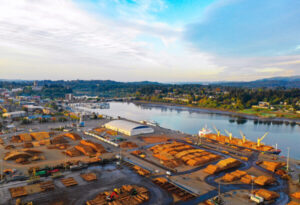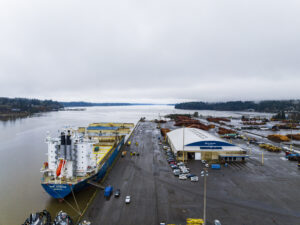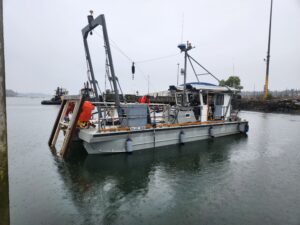Rejuvenating Budd Inlet’s Ecosystem
Where the Money Goes:
The Cost of Preparing for Budd Inlet Cleanup
Environmental investigation and design for large-scale sediment cleanup and habitat restoration is a significant investment that saves money in the long run.
The total cost of investigating the sediment contamination in Budd Inlet and designing a cleanup action to address it is estimated at $22 million. For anyone not familiar with the ins and outs of environmental cleanup, that price tag may be shocking, especially considering the estimate doesn’t include the actual cleanup work.
So where does the money go? Why does preparing for cleanup cost so much and what’s the value of this upfront investment?
Understanding the estimated project cost is the first step toward funding the project.
Estimated costs allow the Port of Olympia to plan for and secure adequate funding to keep the project moving forward into construction of cleanup and associated restoration. Habitat restoration is a component of the cleanup because it will be a requirement as part of obtaining federal permits for the cleanup work.
Environmental compliance takes time, and time is money.
The Port can’t start removing contaminated sediment without a plan and design, including knowing where the contaminated sediment is and what can be done with it. The estimate encompasses the variety of tasks needed for the Port to start work on remediation, including sediment sample collection, laboratory sample testing, chemical and physical data analysis, biological, archeological, structural, and geotechnical evaluations, project design, and permitting. These activities take time, and a robust technical team. In addition to Port staff, a sizeable team of expert scientists, engineers, and planners are hard at work to make Budd Inlet cleanup successful.
Part of what drives the cost are the technical documents and ongoing coordination required by the Washington Department of Ecology, which oversees the Port of Olympia’s cleanup project. Ecology’s oversight of Budd Inlet cleanup is directed by Washington’s cleanup law, the Model Toxics Control Act (MTCA), which grew out of a 1988 citizen’s initiative. These strict technical requirements are meant to ensure safe, effective cleanup of contamination to protect human health and the environment.
Scientific and engineering expertise is expensive.
To determine the types, extent and location of contamination in Budd Inlet, the Port is collecting sediment samples which are then analyzed at an accredited laboratory. Because of the types of complex chemicals driving sediment cleanup in Budd Inlet, a single sample that is analyzed for a suite of chemicals can cost as much as $2,500, or as much as $700 to analyze for a single chemical.
While the Port is being judicious and only conducting a full analysis on selected samples, the number of sediment samples will still be in the thousands. The project area within East and West Bay is large: approximately 500 acres. This doesn’t include areas of Budd Inlet to the North of East and West Bay that are also part of the sediment site. Further, sediment sampling is required in three dimensions. For East Bay, more than 1,100 sediment samples were collected from more than 100 locations. Depending on the extent of analysis, that’s around $1 to $3 million just for laboratory analysis in East Bay alone.
Investigation is an investment.
To clean up the contamination, we first need to know what the contaminants are, where they are located, and where they came from. High quality data is critical to cost-effective and successful cleanup design.
In the case of cleaning up contamination, one size does not fit all. Some areas require dredging. Dredging is typically the most effective cleanup option because it removes the contamination from the aquatic environment, but it is also the most expensive option per acre. The sediment data may reveal areas where alternate cleanup approaches such as capping, or enhanced, monitored recovery can occur, which can save money in the long run.
For Budd Inlet, the Port will likely use a combination of methods, as appropriate, to achieve maximum safety and efficiency. Characterizing the contamination throughout Budd Inlet provides necessary information for determining the best method of cleanup for each specific area within the 500 acres, as well as important data for future monitoring.
Funding will need to come from many sources.
To date, the Port has secured $12 million in funding. The Washington State 2023 capital budget included a $2.2 million allocation from the Department of Commerce for sediment sampling, cleanup design and permitting and $10 million in Remedial Action Grants from the Washington State Department of Ecology.
The Port continues to actively secure additional funding for the cleanup and restoration work through grants, state and federal appropriations, and partnerships. Early in the project, preliminary estimates calculated the total cost of cleanup to be over $100 million. However, depending on the extent of cleanup required and habitat restoration necessary to secure federal permits, costs could be on the order of $200 million. The total cost estimate will be refined as the project moves through investigation and design.
Cleaning up and restoring Budd Inlet is not a simple, quick, or inexpensive project. Proper planning and evaluation are required for project success. Few organizations can take on such an enormous task. The Port has entered into a legal agreement with the Department of Ecology to perform the work and is leading the effort to clean up and restore Budd Inlet. Thanks to tribal, federal, state, and local partners who share a vision of a better future for the inlet, work is well on its way.







